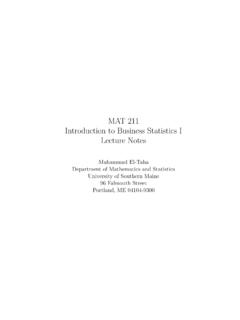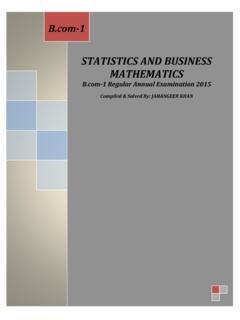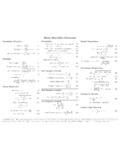Transcription of BUSINESS MATHS & STATISTICS (TC3) - icam.mw
1 BUSINESS MATHS & STATISTICS (TC3) TNMALAWI THE INSTITUTE OF CHARTERED ACCOUNTANTS IN MALAWIBUSINESS MATHS & STATISTICS (TC3)TECHNICIAN DIPLOMA IN ACCOUNTINGBUSINESS MATHS & STATISTICS (TC3)3 January 2014 BUSINESS MATHS & STATISTICS (TC3) TECHNICIAN DIPLOMA IN ACCOUNTINGINSTITUTE OF CHARTERED ACCOUNTANTS IN MALAWI (ICAM) BUSINESS MATHS & STATISTICS (TC3)Copyright Th e Institute of Chartered Accountants in Malawi 2014Th e Institute of Chartered Accountants in Box 1 BlantyreE-mail: ISBN: 978-99908-0-414-0 All rights reserved. No part of this book may be reproduced or transmitted in any form or by any means-graphic, electronic or mechanical including photocopying, recording, taping or information storage and retrieval systems-without the written permission of the copyright MATHS & STATISTICS (TC3)PREFACE INTRODUCTIONThe Institute noted a number of difficulties faced by students when preparing for the Institute s examinations.
2 One of the difficulties has been the unavailability of study manuals specifically written for the Institute s examinations. In the past students have relied on text books which were not tailor-made for the Institute s examinations and the Malawian environment. AIM OF THE MAN8 ALSThe manual has been developed in order to provide resources that will help the Institute s students attain the needed skills. It is therefore recommended that each studentshould have their own copy. HOW TO USE THE MANUAL Students are being advised to read chapter by chapter since subsequent work often builds on topics covered earlier. Students should also attempt questions at the end of the chapter to test their understanding. The manual will also be supported with a number of resources which students should keep checking on the ICAM website. BUSINESS MATHS & STATISTICS (TC3)4 Contents CHAPTER 1 PRELIMINARIES .. 10 CHAPTER 2 FRACTIONS, DECIMALS AND PERCENTAGES.
3 14 CHAPTER 3 RATIOS AND PROPORTIONS .. 21 CHAPTER 4 FUNCTIONS .. 27 CHAPTER 5 SEQUENCES AND SERIES .. 50 CHAPTER 6 INEQUALITIES .. 58 CHAPTER 7 LINEAR PROGRAMMING .. 65 CHAPTER 8 MATRICES .. 71 CHAPTER 9 DATA AND DATA COLLECTION .. 97 CHAPTER 10 SAMPLING .. 106 CHAPTER 11 DATA PRESENTATION .. 116 CHAPTER 12 STATISTICAL MEASURES .. 152 CHAPTER 13 COMBINATORIAL ARITHMETIC .. 180 CHAPTER 14 PROBABILITY 185 CHAPTER 15 REGRESSION AND CORRELATION ANALYSIS .. 201 CHAPTER 16 TIME SERIES .. 229 CHAPTER 17 INDEX NUMBERS .. 256 CHAPTER 18 FINANCIAL mathematics .. 272 CHAPTER 19 CALCULUS .. 298 BUSINESS MATHS & STATISTICS (TC3)5TC3: BUSINESS mathematics & STATISTICS AIM OF THE COURSE To enable the student to understand mathematical and statistical principles and their applications completion of this module, the candidate will be able to: xSolve BUSINESS equations. xSketch graphs of BUSINESS functions xSolve BUSINESS problems using techniques of sequences and series xUse inequalities, where appropriate, to solve simple commercial situations xApply the concept of matrices in BUSINESS xDescribe data collection techniques and sources of data.
4 XPresent data graphically and use data summarization techniques. xCalculate measures of central tendency and dispersion xInterpret measures of central tendency and dispersion xApply the concept of probability in solving BUSINESS problems. xForecast using BUSINESS data. xDetermine the degree of relationship between two variables. xInterpret index numbers xPerform investment appraisal. xApply calculus on revenue, cost and profit functions with the aim of finding optimum points. FORMAT AND STANDARD OF THE EXAMINATION PAPER The BUSINESS mathematics and STATISTICS module will be assessed using a traditional 3 hour paper-basedexamination. The examination paper will consist of two sections; section A and section B. Section A will becompulsory and it will carry 60 marks. Section B will have 3 questions each carrying 20 marks. Candidateswill be required to answer any 2 questions from section B. BUSINESS MATHS & STATISTICS (TC3)6 SPECIFICATION GRID This grid shows the relative weightings of topics within this course and should provide guidance regardingstudy time to be spent on each.
5 Syllabus Area Weighting % Functions, Equations and Graphs 10-15 Sequences and series 5-10 Inequalities and Linear Programming 5-10 Matrices 10-15 Sampling Data Presentation 5-10 Data presentation 10-15 Statistical Measures 10-15 Introduction to Probability 5 10 Correlation and Regression 10 Time Series Analysis 5-10 Index Numbers 10-15 Financial mathematics 15-20 Introduction to Calculus 5-10 Learning Outcomes1. Functions, equations and graphs The candidate will be able to formulate and solve equations from real life situations. In the assessment, the candidate may be required to: equations. linear equations. quadratic equations using graph, factorisation and formula. exponential and logarithmic equations. compound interest problems using logarithms. 2. Sequences and series The candidate will be able to identify patterns in a given set of data and use the appropriate methodto solve real-life problems. In the assessment, the candidate may be required to: an Arithmetic Progression an Arithmetic Progression a geometric progression the of arithmetic and geometric progressions the sum of a given AP the sum of a given GP 3.
6 Inequalities and Linear Programming The candidate will be able to use linear programming techniques to make managerial decisions. In the assessment, the candidate may be required to: simple linear inequalities linear inequalities BUSINESS MATHS & STATISTICS (TC3) inequalities to simple commercial situations the objective function for a given problem. up with constraints from a given word problem. inequalities and determine a feasible region for a given word problem. graphical method to find the optimal solution to a linear programming problem. 4. Matrices The candidate will be able to model relationships between financial or economic variables using aset of linear equations, represent them using matrices and solve such models. In the assessment, the candidate may be required to: i. Represent data with matrices ii. Add, subtract and multiply matrices iii. Apply the concept of matrices in manipulating commercial data iv. Find the determinant of matrices up to 3 by 3.
7 V. Find the inverse of and matrices. vi. Solve systems of linear equations (up to 3 variables) using the inverse method and Cramer srule. 5. Sampling and data collectionThe candidate will be able to choose among the various methods employed in choosing the subjectsfor an investigation and differentiate the different ways of collecting data. In the assessment, the candidate may be required between data and information data between data collection methods and select a suitable method stages in statistical investigation6. Data Presentation The candidate will be able to present data using various data presentation techniques. In the assessment, the candidate may be required data using various techniques: pie chart, pictogram, bar chart, frequency tables,histogram, Ogive, Lorenz curve and Z chart. an appropriate data presentation technique for specific data basing on type of data athand, and advantages and disadvantages of the technique.
8 7. Statistical Measures The candidate will be able to calculate and interpret measures of central tendency and dispersion. In the assessment, the candidate may be required measures of central tendency from simple data: mean, mode, median, geometricmean for grouped and un-grouped data. measures of central tendency measures of dispersion: range, mean deviation, variance and standard deviation,quartile deviation, coefficient of variation and skewness for grouped and un-grouped data. measures of dispersions distributions using summary measures BUSINESS MATHS & STATISTICS (TC3) the skewness of a distribution: Pearson s measure of skewness the skewness of a distribution 8. Probability The candidate will be able to calculate and interpret various types of probability. In the assessment, the candidate may be required to: the role of probability in decision making the classical, empirical, and subjective approaches to probability experiment, event and outcome the rules of probability: addition and multiplication rules marginal and conditional probabilities a tree diagram to organize and compute probabilities 9.
9 Correlation and regression The candidate will be able to determine the relationship between two numeric variables compute the strength of the relationship. In the assessment, the candidate may be required to: the meaning of regression analysis practical examples where regression analysis can be used scatter diagrams a simple linear regression model estimates of the unknown variable using the regression model and interpret the Pearson product moment correlation coefficient and interpret the Pearson product correlation coefficient and interpret the coefficient of determination 10. Times Series Analysis The candidate will be able to use time series data to forecast events or activities. In the assessment, the candidate may be required to: time series data times series models components of a time series: Trend, Seasonal, Random and cyclical variation. a time series into its components: Trend and Seasonal variations using moving time series to make forecasts and interpret de-seasonalised data.
10 11. Index Numbers The candidate will be able to manipulate different published index series and construct new index series. In the assessment, the candidate may be required to: what an index number is. between base year and current year single item indices (price and quantity). between weighted and un-weighted indices. BUSINESS MATHS & STATISTICS (TC3) the base of an index number the Laspeyres and Paasche Indices and explain the difference changes in economic data using indices nominal money values into real terms (taking inflation into account) 12. Financial mathematics The candidate will be able to solve problems involving depreciation, interest calculations andinvestment appraisal. In the assessment, the candidate may be required to: interest, principal or period in given various combinations of parameters the different techniques of depreciation. an asset using the various depreciation techniques an investment using payback period, Net Present Values and Internal Rate the various techniques of investment appraisal the maturity value of an annuity periodic payments for a sinking fund the fixed equal payment of annuity given the maturity value amortisation as a method of debt repayment 13.














